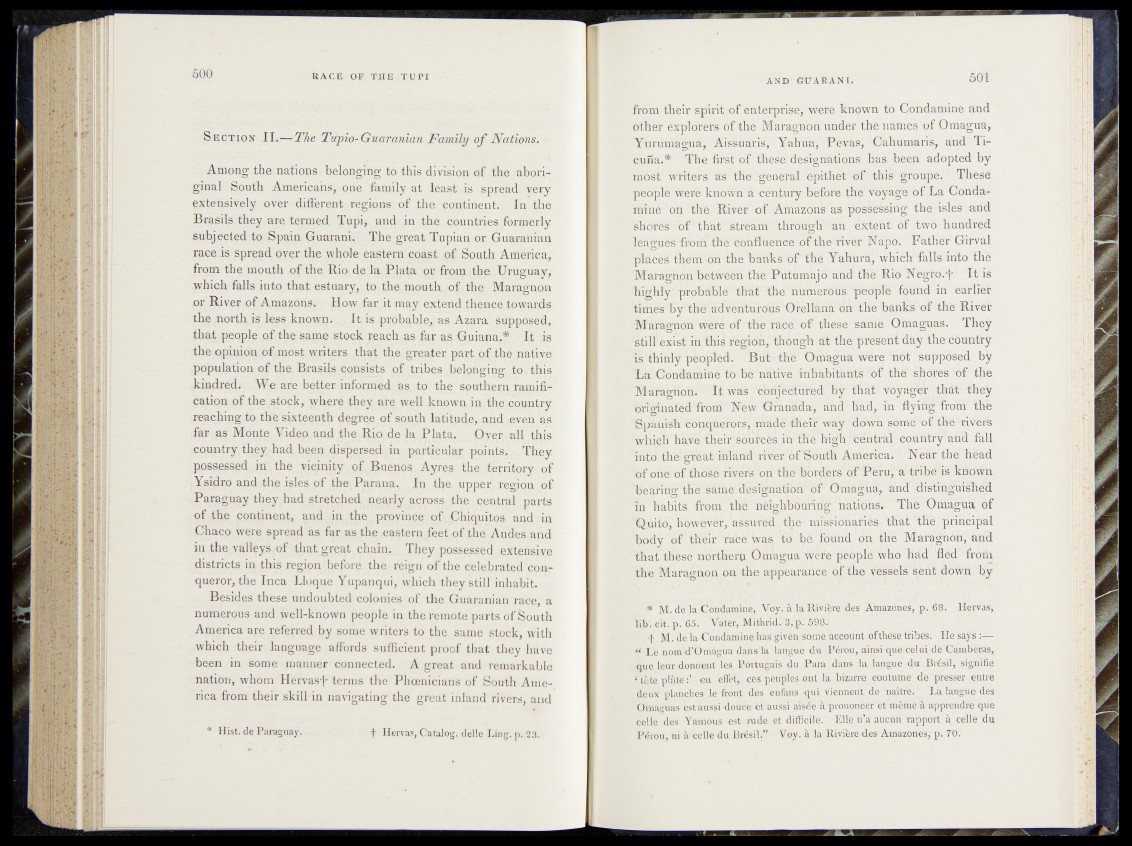
mo RACE OE THE- TUFI
S ection II.—The Titpio-Guaranian Family of Nations.
Among the nations belonging to this division of the ab.q>|V
ginal South Americans,, one family at least is spread very
expensively, over different regions of the continent. In thfe.
B^asils they are termed Tupi? and in the countriespiormerly
subjected to Spain Guarani. The great Tupian or Gu^wanian.
race is spread over the whole eastern coast ojf Sputh America^
from the mouth of the Rio dp la Plata* op frpn^ the Uruguay,
which falls into that estuary, tq fhe mouth of« the Maragnon
pr River ufAmazqns* Hoy? f far i| may extend thepceipwards
t^ n o r fh i s , k n p w n . It is prob^bl^ as Azara suppps^d,
ih a t people pft^e sjaine stock jje& ek ffir as ^Hiana^^, (It is
thejopinion of rnpst writers that thm greyer part of thejaative
population of the. Brasils consists of ti;ib^ (be]pnging to. this
kindred. We are better informed as to the. southern rami fic
tio n of the stock, where they arjf( wed kpown indh^couptry
reaching to the sixteenth dpgrqe qf sputh latitude, aqd,t§yen as
fpr as Monte Vide# and the .Rio dp la Platav Oven»aft tjiiis
country they had^pjyi dispersedi in particular points. They,
possessed in. the vicinity of , Bu^qps Ayrep: the „territory pf
Ysidro and the isles.pf thp. Parana. In the upper region of
Paraguay they;had stretchedr.;nearly a|ross. ^hp qentral parts
of the continent, and in the province ofvphiquifps and in
Ohacp were spread as far as fhe ^eastern feet pf jtiie; Andes, and
in the valleys,of that grept chain. They possessed expensive
districts in this regipn befpr'p the reign of the. celebrated conqueror,
the Inca Lloque Yupanqur, which they stilf inhabit,
j Besides these undoubted colonies of the Guaranian race, a
numerous and well-known people in the remote parts of South
America are referred by some writers to the same stock, with
which .th6ir language affords sufficient proof that they have
been, in some manner connected. A great and remarkable
nation, whom Hervasf terms the Phoenicians of South America
from their skill iti navigating the great inland rivers, and
AND GUARANI. 501
from theirisptrit bffêhterprisej,' were known to Condamine and
other explorers of t'®è^^rn?^î^n,’under the names'!of Omaguay
Yirrutriaghây Yahha, P%vas, Cahumariis, and Ticuna.*
Thc^ffifeV'of'ttofe§ëfHesig.natippâ’has'been adopted by
wf-îtefo"' as thilgfferal é^^hw^of thistfgrcmpe. Thesê
fieopte were known’*£ century oeffifê the voyage of La Conda-
mihè"on- thles Rbvërffof Amakbh‘s- W,*pb^e£sing;‘‘the isles and
shdfëS'1' of 'that strèahM?tH'fd&gh,*> ah of tWb hundred
Wa^hfe!Jfrbm thétb^üfldbf^mm the1 river Nap'ô.1 "Fiiérief Girval
•pldcést /hërxi on the hanks'of the Y àhùrd| which-falls into'thé
'M'àVà^feohÇbët^vêéii the Pdtumajct and tffè Rio NfegfoOf- It ii
the numerouis','^ëopfôrfo'ühd in earlier
tir i^ lly ' fhe‘ad vèhturo'iiS Orelllrip' bn the1 hanks of'the River
Mâr’â'ghbn-weté of' t h 'b f H f r e s e ' isâîiië ‘Otha^ias'.They,
emSrtMii this f%I$n; thodgft i t the^ffifeeht day tbe'cbuntrÿ
is thinly peopléif. r 'Bdt- th'b1 Otha^üa were'îh'bt’thà^flbsëd'' by
Ta Condaminé tb bd hâtiVè inhabitants h r thè*' shlfei?*w ! the
Mara'gné&1jTf v^di febrqhctiiféd ; oÿ thaï voyager that! they
ofr^rhaled from (PféW Gr4n\ida, ànd ifâd, în flying- rroni thè
l^ âh ish dbnquëfbfà'.1 tnadé their way d’cfWù’ somè! oflhb'fi've'rs
Which hkvfe thei'f'éburcès ih'fhe hîgfiVehtral cqutitfÿ,Jahd. fall
into the'jgibât inland river hf‘South America. iNfedri the'4iëàd
^of onë of tho’sk rivers on the'bbrdérs of Peru, a' tribe'is 'knowh
*bekririg the^âme dèsignalîôh\ of Oma^ua, and*! distth^iiièhéd
'in habits from1,.the neighnBuAh^ ndtioas.'' The Omhgah' of
"'Quito, however/assured the missionaries that Ihë'^riticipal
body ]of their race Was tù bè 'fôùnd ou the Maragnon,l Jahd
that tlieWd'northern Omagua wèfe people"'who’had fléd frohi
the Mardgnon on. the appearance of the vWébF&'fsehï doWïi by
* M. de la Çondamine, Voÿ.Hà la Rivière des Amazones, p, 68. Hervas,
lib. cit. p. 65. Vater, Mithrid?'à,p. ^98?
f M. delà Condamine ha’s givensome account of these tribes: île sa^s
■ x* Le nom d’Omagua dhnsJla langue dm'PéVbu, ainsi•qu^ifel'âi-dé'Cambetas,
que leur donnent les Portugais du Para dans la langue du Brésil, signifie
‘ tête plâte en effet, ces peuples ont la bizarre . coutume,,de presser .entre
5 deux planche? le front des enfans qui viennent de naître. La langue des
Offiâ<mas est aussi douce. e€ aussi aisée à' prononéèr et mème'% a-ppïendre que
''Celle des Yamous est rude et difficile. Elle'n’a aucun rapport à celle du
Pérou, ni à celte du Brésil.” Voy. à la Rivière des Amazones, p. 70> ""